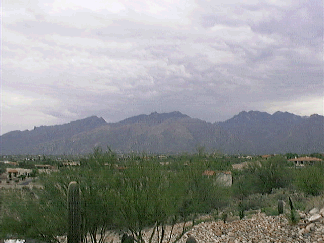|
Entertainment Magazine: Tucson: Santa Catalina Mountains The Lost Santa Catalina MissionThis is an excerpt from the book "Treasures of the Santa Catalina Mountains" by Robert E. Zucker. Download a free PDF sample of the book and purchase on Amazon.com. The old Spanish Santa Catalina Mission was originally named by Father Eusebio Kino during his first journey into the new land of Pimeria Alta. The first location was about 30 miles west of the Santa Catalina Mountains. Kino described it as "ten leagues north" of San Xavier Mission. But, about a decade after his death, the mission location was reportedly "seven leagues ot the east" of San Augustine (west of present day Downtown Tucson). That woud place it near the base of the Santa Catalina Mountains. The legend of the lost mission is tied to the legend of the famed Iron Door Mine. Did a mission really exist?
The Santa Catalina Mountains and the legend of the Lost Mission. The location of the Santa Catalina visita (village where the priests visted) was first placed about 25 miles north of Tucson, along the Santa Cruz and northwest of Picacho Peak Later, seems Sta. Catalina had been “pulled back to a location in the Cañada del Oro 8 or 10 miles north of Black Mountain and close to the Santa Catalina Foothills, gaining its Saint’s name.” Moved again by Middendorf’s time. (“Tucson,” Sonnichsen, 11) 1687, Father Eusebio Kino came to Pimeria Alta (now present day Southern Arizona and Sonoran, Mexico) in support of a royal cédula, issued by the King of Spain. Kino used this edict to promise the natives that they would not be forced to work in the mines - if they converted to Christianity. The “missionary (is) named for the reduction and conversion to our Holy Faith of the Seris, Huaymas, and Pimas in the province of Sonora, Kingdom of Nueva Vizcaya, regarding taking Indians under seal to work in mines, undated, but passed on by the Audiencia December 16, 1686; and petition of Father Azcarasso, undated, but considered May 2, 1687.” (From Kino’s “Memoir of Pimeria Alta,” 107). 1699-1752 (closed) “Santa Catarina del Cuytoabagum Visita” (Pima), (Rio Santa Cruz) (Source: Guide to Catholic-related Records outside the U.S. about Native Americans, Marquette University, San Xavier del Bac Mission History; Durango Archdiocese and Archdiocese of Mexico: before 1767 closed). Note: Date differences depend on end Pima Indian uprising (1751) or when Jesuits expelled (1767).
Treasures of the Santa Catalina MountainsTucson Entertainment Magazine© 2012-2018 EMOL.org / Tucson Entertainment Magazine On Line. All rights reserved. |
